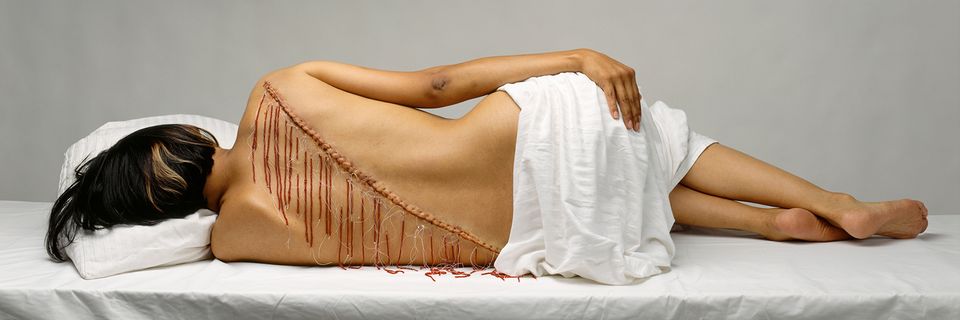
Rebecca Belmore (Anishinaabe), Fringe, 2007, transparency in light box (one of an edition of three), Minneapolis Institute of Art, Gift of funds from Donna and Cargill MacMillan Jr., 2010.56. © Rebecca Belmore
Artist’s Language
Rebecca Belmore moozhag aabajitoon ikwewiiyaw wii-waabanda’ang ezhi Anishinaabekwewag mashkawiziwaad miinawaa zhiibinewaad. Ikwe bimishin dibishkoo ikweyan mewinzhaa mazinibii’igaazonid Waabishkiiwewakiing idash mizhwaaginiwid dinmaaganing ako nooganing. Ojiishigikaazo ge manidoominensikaadang dibishkoo ziigiskwed ezhi naagwag. Belmore waabanda’aan Anishinaabewid mii gaye ezhi Anishinaabewan zhiibinenid. Misawa dash getenaam mizhwaaginiwid, Niisiiwezhigan gaye izhi-noojimong. Ojishigiwin apane wii-naagwad aanawi dash manidoominensikaadeg daa-waabanjigaadeg Anishinaabe zhiibinewin.
English
Rebecca Belmore often uses the body to address violence and injustice against First Nations people, especially women, and the power of resiliency and survival. The female figure in Fringe assumes the same reclining pose as women in European art history, but she bears an ugly slash from shoulder to hip. The deep scar is special-effects makeup, and the thin rivulets of blood running from the gash are composed of small red beads. This detail evokes both Belmore’s heritage and the trauma inflicted on Indigenous peoples. Despite the graveness of the woman’s injury, Fringe is also about healing. The scar will never disappear, but it is stitched together with beads that symbolize Indigenous strength and survival.













